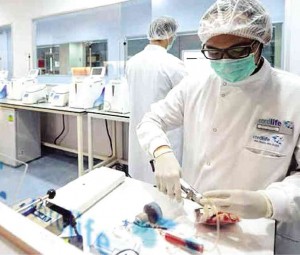
CORDLIFE is now the largest network of private cord blood banks in Asia Pacific with state-of-the-art cord-blood and tissue processing and cryopreservation facilities in the country.
Once considered a medical waste, the blood left in the umbilical cord—the part of the placenta that delivers nutrients to a fetus—after a baby is delivery is now known to be a rich source of blood-forming stem cells.
These cells have been found to be potentially useful in treating diseases that require stem cell transplants (also called bone marrow transplants) such as certain kinds of leukemia or lymphoma, aplastic anemia (a blood disorder in which the body’s bone marrow doesn’t make enough new blood cells), severe sickle cell disease and severe combined immunodeficiency.
Unlike with bone marrow, which is obtained through a painful medical procedure, there is only one chance to collect this seemingly precious stuff: immediately after the baby’s birth.
This is why a number of expectant parents in the country are being offered a chance to save stem cells from their baby’s umbilical cord blood via what is known as cord-blood banking.
Safeguard
Cordlife Philippines medical director Arvin Faundo said: “It’s a type of safeguard because the genetically unique stem cells have current and potential uses in medical treatment. No parent wishes his/her child to experience the heartbreaking effects of any illness. What we at Cordlife offer them is the chance to prepare for potential eventualities—to secure the future well-being and happiness of their family.”
Cordlife Philippines is a subsidiary of Cordlife Group Ltd., a company listed on the Singapore Exchange. Launched in February 2010 as the Philippines’ first and only cord-blood processing and cryopreservation facility, its facility was ISO-certified and built in accordance to global gold standards such as the American Association of Blood Banks.
The 365-day facility, located within UP-Ayala Land TechnoHub in Quezon City, is equipped with the world’s most advanced fully automated cord-blood processing system, the Swiss-made Sepax.
CordLife uses the US FDA-approved cryogenic storage pouch.
Early this year, the facility has been upgraded so its state-of-the-art processing and cryopreservation laboratory could accommodate up to 30,000 cord-blood and cord-lining units.
Investment
Like any insurance, cord-blood banking isn’t cheap. Cordlife’s umbilical cord banking service starts around P40,000 plus an annual fee. Also available are prepayment plans that offer more savings.
But considering the average cost of a car or the cost of hospitalization, many expectant parents feel it’s a reasonable price to pay to give their children the best chance in life.
Certainly, many doctors who have high hopes for stem-cell advances advise patients to consider cord-blood banking.
Faundo said a number of their clients, for example, babies Justin and Georgia, have benefited from their stored cord blood.
Baby Justin was diagnosed with neuroblastoma (a cancer that develops from immature nerve cells found in several areas of the body) and at one and half years old, he had endured numerous rounds of high-dose chemotherapy.
The chemotherapy destroyed his cancer cells as well as normal cells. Fortunately, Justin’s parents had his cord blood stored at birth and were infused back to his body after a course of chemotherapy in January 2011 at Queen Mary Hospital. Justin was discharged from the hospital after three months.
On the other hand, an accident at birth two-and-a-half years ago deprived Baby Georgia of oxygen for her brain, which resulted in cerebral palsy. This caused her to move involuntarily, suffer from muscle spasms and have up to 50 seizures a day.
It was only after Cordlife put the family in touch with a renowned neurosurgeon that enabled Georgia to be infused with her own cord blood. Her conditions have improved since then as she has been observed to exhibit better visual focus and eye contact with adults during play. Even her postural and head control has been observed to have improved, according to her doctor.
Faundo said: “What babies Justin and Georgia both benefited from is their parents’ decision to secure their umbilical cord blood even without the foreknowledge of the health challenges life will throw at them. Both parents entrusted what they deemed to be an important medical resource with Cordlife, Asia’s most respected cord-blood bank with more than 12 years of experience and published cord-blood release track record for treatment.”